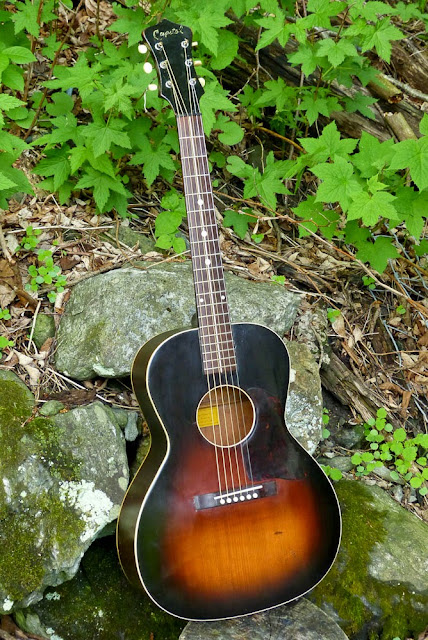1930s Gibson-made Capital J-1 Flattop Guitar
The Capital brand was used in the 30s by the J.W. Jenkins Company (retailers) for their line of "in-house branded" Gibson-sourced products. They were already a Gibson dealer at the time but Gibson made an offshoot line (similar to Gibson's own Cromwell -- as well as Kalamazoo -- offshoot lines) with the Capital brand on the headstock. This is basically a gussied-up version of the Kalamazoo KG-14 and appears identical (save for the headstock stencil) to their own in-house Cromwell G-2 model. As I recall, only 70 or so of this model were made.
This one is in as a consignment and while this had some previous repair work done, my work included a fret level/dress, bridge shave and new bone saddle, new bridge pins, tuner lube, cleats for two top cracks, and a good setup which included removing a terrible Bridge Dr. contraption. It now plays quite well (standard 3/32" bass and 1/16" treble action at the 12th fret) and has a good, bluesy tone (perfect for fingerpicking) but does have some obvious top bellying and some condition issues I'll note as I go along with the photos. I've got it strung with 50w-11 strings and it's stable in service.
This one is in as a consignment and while this had some previous repair work done, my work included a fret level/dress, bridge shave and new bone saddle, new bridge pins, tuner lube, cleats for two top cracks, and a good setup which included removing a terrible Bridge Dr. contraption. It now plays quite well (standard 3/32" bass and 1/16" treble action at the 12th fret) and has a good, bluesy tone (perfect for fingerpicking) but does have some obvious top bellying and some condition issues I'll note as I go along with the photos. I've got it strung with 50w-11 strings and it's stable in service.
The top and headstock both have overspray and the pickguard is, apparently, a replacement. It's quite close to the original shape/style, though. There are two hairline cracks (cleated) on the lower bout which will be more visible in later photos, but overall the guitar is in stable, good-to-go condition.
The original finish was preserved under the topcoat and shows the old weather-check and crackle you'd expect to see on an old Gibson product.
While I specified 1930s, this one probably dates to around 1936-37, judging by the headstock and lack of side dots. The original ebony nut was quite reusable.
Big pearl dots and a cream celluloid stripe decorate the radiused, rosewood fretboard. This guitar has a 1 3/4" nut width and a big V-shaped profile. The scale length is standard 24 3/4" Gibson scale. I like it for cowboy chords and fingerpicking but some closed-position chords aren't as friendly up at the join, especially, if you're used to thin necks. These guitars (like all KG-14 style guitars) have a lot of snap, punch, and volume which really suits an old-time jam situation where you need to take leads or do fills next to another guitar playing backup.
The neck itself had minor warp which was dialed-out in the fret level and dress... this means, though, that the first two frets are fairly low... though all the frets are that older low, smaller stock anyhow so it's not obvious. It plays swell.
The bridge got a bit of a shave and polish-up. It had a sort of grungy reglue and I cleaned up that muck. The saddle is new bone and compensated. The pins are also new cream plastic ones. When the bridge was reglued, someone did it with bolts, apparently, as the bridge wings have filled "dots" in them if you look closely.
The L-00 body shape sure is classy.
The back, sides, and neck all have the original finish which looks like it's been humidity/lightly heat-fogged. It's got that old "Oscar Schmidt" look to it.
Plenty of use-wear on this fella! There are only two back cracks, however, at the upper-bout... and one smaller one on the lower bout... and they've all been rudimentarily but effectively cleated in the past.
The strip tuners work fine after a lube. It looks like the mounting screws are old replacements, though.
That ding is nothing... but a ding. The back, sides, and neck are of course all solid mahogany and like the Cromwell G-2, this J-1 has added binding on the back edge vs. a standard KG-14 style guitar.
Lotsa play!
The bass "side" has this tight, good-to-go hairline at the waist. It's the only real side crack.
The endpin is original.
Here are those old cleats. There are also a couple of random cleats on the top above these that I can't quite fathom. They don't effect tone at all (since they're in a stiff part of the build, anyway) but there are 2 or 3 small ones up there. Two of them are acting like those small "wing" braces that run around the soundhole edges on an x-braced guitar.
Here's the belly to the top that I mentioned before. It's stable in service but not ideal aesthetically.
Here are those two hairline cracks (which were filled but not repaired in the past) that I cleated-up for safety's sake. They're nice and tight.























Comments
It's no longer in playable condition (the guitar, not the pig) but it now hangs in my den. I can't tell you what became of the pig.